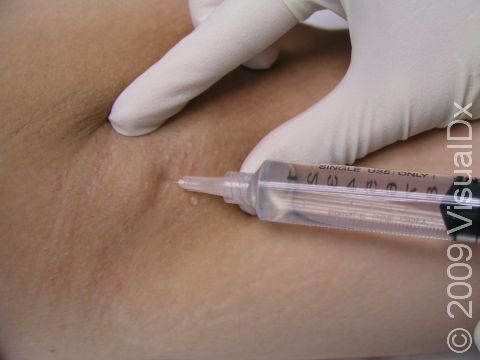Local Anesthesia for Dermatologic Surgery
To minimize pain and discomfort during certain medical procedures, local, regional, or general anesthesia may be used. The type of anesthesia used for a procedure depends largely on the procedure itself, location on the body where the procedure will be performed, and any underlying health conditions you may have.
Most minor surgical procedures of the skin, such as skin biopsies, will require an injection of local anesthesia into the skin. Unlike general anesthesia, which causes unconsciousness, local anesthesia allows you to stay awake and conscious during the procedure.
The most common medication used as an injectable local anesthetic is lidocaine. Epinephrine is also commonly added to lidocaine preparations to clamp down blood vessels and minimize bleeding. Lidocaine mixed with prilocaine is a commonly used topical anesthetic cream, and ethyl chloride is a commonly used spray.
If your medical professional prescribes a local topical anesthetic to apply at home prior to a medical test or procedure, be sure to follow the information provided regarding how much cream to use, where to apply it, how far in advance to apply it prior to the in-office visit, and how to properly cover the area. Applying topical local anesthetic too early is not advised because it can be absorbed into your bloodstream and cause negative side effects.
What to Expect During Your Visit
Prior to local anesthesia, a supplementary cream or gel may be applied and covered with an adhesive bandage or dressing 15-30 minutes prior to the procedure to dull the minor pain associated with the anesthetic injection, or an anesthetic spray may be used. The medical professional will clean the involved area, such as with an alcohol wipe. In the case of injectable local anesthesia, a small needle attached to a syringe is inserted into the skin, and a numbing solution is injected around and within the area to be removed or treated. You may initially experience a brief stinging sensation related to the needle and the anesthetic being introduced. Within seconds to a minute, typically, the area becomes numb.
Local topical anesthetic given as a cream, gel, or spray should be effective once it has been on the skin for the prescribed length of time. You will still have sensation in the area; it will help reduce pain but may not eliminate it completely.
What to Expect After Your Visit
Following local anesthesia, you should start to regain feeling in the area within a few hours.
Follow-Up Care
No follow-up care is necessary specific to local anesthesia. Follow your medical professional’s advice following the procedure or treatment the local anesthesia was needed for.
Risks and Potential Side Effects
Risks and side effects associated with local anesthesia depend on the local anesthetic agent used, the technique, and the site of administration. Local anesthesia is a common and safe office procedure, but risks and side effects occurring at the site of injection may include bruising, allergic reaction, and injury to nerves or muscles.
It is important to talk to your medical professional about any possible allergies you have so they can choose the proper local anesthetic.
When to Seek Medical Care
Contact your medical professional following local anesthesia if you experience numbness that does not resolve within a day, itching, hives, or swelling.
Seek urgent medical care following local anesthesia if you experience difficulty breathing, slurred speech, or difficulty swallowing.
References
Kouba DJ, LoPiccolo MC, Alam M, Adamson T, et al. Guidelines for the use of local anesthesia in office-based dermatologic surgery. JAAD. 2013 Mar 4;74(6):1201-1219.
Rękas-Dudziak A, Męcińska-Jundziłł K, Walkowiak K, Witmanowski H. The use of local anaesthetics in dermatology, aesthetic medicine and plastic surgery: review of the literature. Postepy Dermatol Alergol. 2023;40(1):22-27.
Last modified on May 3rd, 2024 at 1:22 pm

Not sure what to look for?
Try our new Rash and Skin Condition Finder
